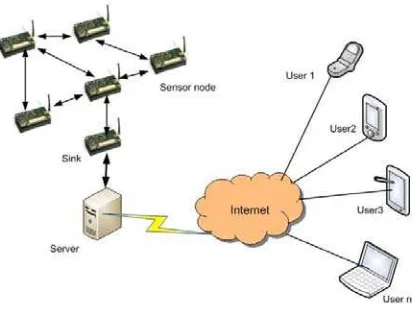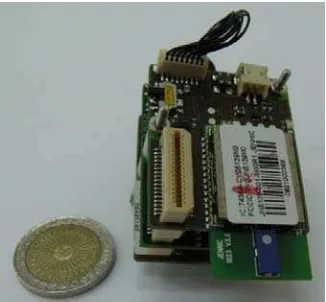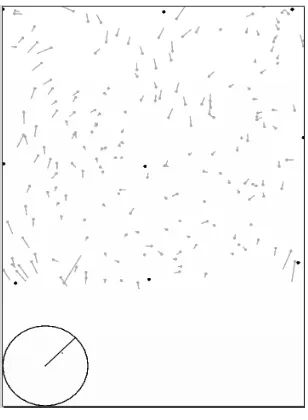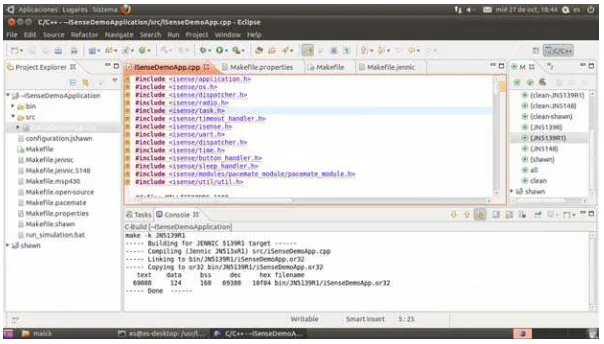On the Road to a Global Wireless Sensor Network
Eduardo O. Sosa1,a , Stefan Fischer2,b, Francisco J. Diaz3,c
1Facultad de Ciencias Exactas Químicas y Naturales, Universidad Nacional de Misiones,
Félix de Azara 1552, N3300LQH Posadas, Argentina
2Institut für Telematik, Universität zu Lübeck, Ratzeburger Allee 160,
23538 Lübeck, Germany
3Laboratorio de Nuevas Tecnologías Informáticas, Universidad Nacional de La Plata,
Calle 50 y 120, 1900 La Plata, Argentina
aes@fceqyn.unam.edu.ar, bfischer@itm.uni-luebeck.de, cjdiaz@unlp.edu.ar
Abstract.This work has considered the development, testing, configuration and implementation of a wireless sensor network infrastructure. This infrastructure on a testbed scale has been used primarily for research, oriented to an interdisciplinary approach that encompasses the hardware, software, algorithms and data. It sought to demonstrate that the heterogeneity of devices and small existing structures may coalesce into well-organized, large-scale, different existing grids that will enable a quantitative and qualitative research to a much larger scale by addressing the dynamic changes of venues, infrastructure and composition of nodes. Considering that a real implementation is usually a complicated task, we have performed a network simulation and a real testbed. Also a contribution to the establishment of a global network of wireless sensors has been highlighted, distinguishing three sub domains in the global network considered: the existing top network, the sensing devices and the servers.
Keywords: WSN, testbeds, infrastructure
1 Introduction
Mark Weiser envisioned that the development of ubiquitous computing is the future scenario, and that it will interact seamlessly with human users [1], [2]. Ubiquitous computing is synonymous with the evolution of electronic devices through the miniaturization and the increased socialization of online content.
an increasing scope of network linked physical devices. Moreover, as component technologies are becoming smaller, faster and cheaper it will continue to do so.
Miniaturization is a reality in most aspects of everyday life, as it also is the capacity of embedding computing and communications technology of spreading far and wide.
While this is achieved with the proposed improvement in calculation and storage performance, research on the application of this technology is designed to reliably determine which will be the new role of computers in science during the XXI century. IT will eventually become an invisible component of almost everything in everyone’s surroundings.
Ubiquitous computing fits a large number of technologies and applications, from mobile devices, "smart" artifacts for special purposes.
A special analysis of radio frequency identification (RFID) becomes necessary. It consists of a system to storage and retrieve remote data, which is used by devices called tags, cards, transponders or RFID tags. The main purpose of this technology is to transmit the identity of an object, similarly to a code or serial number, using radio signals. The elements needed to enable the system are the RFID tags and RFID readers, elements that allow the physical object “be seen” and monitored by an existing computer network.
Scientifics and researchers talk more and more about a "ubiquitous network society" [4], [5], a society where networks and networked devices are omnipresent.
When talking about worldwide competition, efficient IT systems which can supply comprehensive and in time data, are essential, and this conveys the need of a continual stream of information from industry appliances to business applications, uniting thus many eclectic systems.
There should have some devices that could be used as an interface for the physical world to become more “friendly” with computer networks, making the conditions of objects and their surroundings perfectly and indefectibly accessible to software systems. RFID and WSN offer a wide range of networked and interconnected devices which afford significant information no matter where the user is. Home appliances, automobiles or farm machines can be in a communication range, shifting from today’s Internet, the internet of data and people, to the Internet of tomorrow, the Internet of things, namely global communication network springing out of the dissemination of such devices and increasingly developing.
Often, the ultimate goal of an action is to get valid information from the field where we are interacting with. In many situations, it would be difficult or extremely expensive, to carry on a surveillance project by using a system where the interacting elements with the event are connected by physical links such as copper wires. For such situations there is a new technology based on a new paradigm, Wireless Sensor Networks (WSN). These networks should not be considered as another step in the evolution of the personal computer or the Internet, it is rather thought as the beginning of the end of personal computers.
Of course it is advantageous to perform precise simulations or to develop models before deploying WSNs in the field. This is because WSNs may be deployed randomly in an ad-hoc manner with a large number of tiny nodes. Simulations help to evaluate the performance of sensor networks within certain application environments, something impossible to achieve not many years ago.
We cannot feasibly model analytically a WSN and what is more, deploying testbeds means a great effort; consequently, if we are to study WSN we must resort to simulation. To do this we need a suitable model based on solid assumptions and a suitable framework to easily accomplish it [7]. Besides, the results of the simulation which are dependent on the environment, the hardware, and certain other assumptions, often not sufficiently precise to depict the actual behavior of a WSN, jeopardize much of the results. Usually most simulators bring forth issues related to scalability and performance; this is so because of the many devices depicted on the simulated applications.
At present there is not such an active testbed in Argentina, and as result of this work, a fully operative WSN is ready to serve as scenario for any joint research-development project with national or foreign partners. Thus practical result will serve to support research and development devoted to the subject in the region.
However, in most cases, when assessing the needs at normal scale, the implementation of a real pilot testbed is usually a complicated task, often for financial reasons. Whether possible, an integrated use of possibilities should be performed, this means to investigate the network simulator and the real testbed. The physical implementation of testbeds stands for accurate and replicable testing; nevertheless, this approach experiences two serious limitations, namely a) large scale, due to costs; and b) not replicable environment. The major challenges for the use of simulators and testbeds are: 1) Sensor node simulation. 2) Testbed visualization. 3) Interaction between simulated scenario and the practical deployment [8].
Whenever an experience can happen in the real world it is quite engaging since it is a confident way to demonstrate that the application can perform a precise assignment wherever the technology is at hand. Yet, unpredictable environment influences make it quite difficult and nearly impossible to present the results and to set apart sources of error, that influences the problem to be considered [9]. Therefore normally testbeds are often limited to a few dozen devices [10]. In future scenarios the building of networks will consider a very high number of nodes, reaching up to several thousand or even millions [11], [12].
Although there exist frameworks for general purpose, to develop a new application in a specific field will demand large experience and skill in a wide scope of technologies. Consequently, smart devices and WSNs are yet not fully exploited. Concerning the integration of application for business, there have been so far few projects which have empowered new architectures with more flexible software. Still, the use of hybrid web applications (mashups) has mainly been used on on-line service and not on physical world analysis, which is our main intention.
may coalesce to form well-organized large-scale, different existing grids that will enable a quantitative and qualitative research to a much larger scale by addressing the dynamic changes of venues, infrastructure and composition of nodes.
2 Material and Methods
When we talk about WSN to monitor micro environments, we note that because of its auspicious and encouraging capability it is becoming very popular. Even though, the majority of systems used for monitoring environment that appear in the literature are those applied only in specific applications and with no use of functions that may work on the user’s data processing methods. The hardware working style we have chosen is one of application-oriented, whereas the system platform to acquire information, validation, processing and visualization is orderly presented. The system capability to draw forth useful information can be guaranteed through several approaches.
Sensors connect to Internet creates endless opportunities in terms of applications and services on emerging patterns of operation. Internet users will be able to obtain real time information from our physical scenario over any item, anywhere and anytime. These investigations have been carried out in parallel, and often in isolation, making it impossible to establish a unified global framework.
[image:4.595.202.409.451.609.2]The results of experiences can reveal the path reliability as well as real-time characteristics, and can also show the system viability and capability in practical use. Figure 1 shows the system architecture of the testbed installed, where the three levels involved can be observed.
Fig. 1 System Architecture of the deployed testbed
the nodes. If we are to design this tier, the choice of the manner of sensing, of reporting and the packet routing protocol must be decisive.
The server level: captures and processes any packet transferred by the sink, in this case through an USB cable; this information afterwards is forwarded to the upper processing program where they are processed. Besides; at this level it is possible to send the packets received over the Internet, where the information can be read by the user.
The user level: Data can be accessed by remote users with web browsers in a way that they can assemble/collect and see the packets from the Server, thus being able to visualize a real-time monitoring of the system. Concerning the security of WSN, users can only survey data and they are not allowed to change parameters of the basic tier.
Although some aspects in this WSN may be generic, the specific demands of the application are significant, especially in scenarios like environmental monitoring. When doing this, a number o sensors are deployed in an area for measuring meteorological parameters, namely temperature, speed and direction of winds, moisture and pressure; and as they tend to change quite slowly, sparse sampling is conceded. Usually, nodes use to measure their contiguous space and send data packets in any of the three following ways: timer-based, event-driven, and requirement-based.
In our micro-environmental monitoring network, we did not have troubles with the energy demand of the nodes, because of the technology of the nodes applied. The only task for sensors is to measure and send the information in due packets according to approximately the internal timer frequency. The more the measuring instances are, the greater the energy used and consequently a shorter lifetime. On the other hand, lower frequencies of measurements leads to a lack of sensitivity of environment changes.
It is widely known that applying multihop techniques in WSN renders a longer lifetime saving much energy from the batteries. So far, we have not experienced such a scarcity because of the solar energy harvesting system provided by our weather station nodes. Furthermore as the information is relayed to sinks, scalability is enhanced.
In a typical WSN application, the observer is interested in tracking phenomena under certain restrictions of latency and accuracy. In a typical WSN, each individual sensor node performs the measurement of the values required, and disseminates this information to other members of the network, and eventually, to the observer. The different events of a given phenomena are measured as discrete samples, which will depend on the precision and accuracy of the sensors, and the location thereof. We have deployed hardware provided by iSense [13] as platform for this experimental work.
Since our WSN uses the iSense operating system and firmware, the generation of small, but complete applications, are allowed. This provides a solid foundation for rapid application development. It furnishes a C++ API to the hardware of the node, functionalities of operating system and a wide variety of network protocols.
distributions was adopted. The necessary applications have been installed such as: make, cmake and gcc++. The iSense platform is based on a Jennic processor, which depends on the ba-elf-g++ integration of libraries and compiler to assure well done applications. The figure 2 shows the comparative size of the device to a coin.
Fig. 2iSense core and attached modules compared with a coin
During the running period we have used several modules attached to the main one, namely: gateway module, Security Sensor module (infrared PIR and 3-axis accelerometers), weather sensor module (temperature, relative humidity and barometric pressure), and environmental sensor module (thermometer and light intensity). In these experiences an energy harvesting system has been adopted, to generate energy and store it in a rechargeable battery, allowing the nodes to run all-time autonomously, using the power management module.
The program language used for developing applications for the sensor nodes is C++. The compiler used on both Linux and Microsoft Windows environment was GNU Compiler Collection. “GCC, includes front ends for C, C Object-oriented, C++, Fortran, JAVA and ADA, as well as libraries for these languages (libstdc, libgcj, etc)” [16].
As a simulation environment Shawn was implemented[14]. For testing, configuration and deployment of applications developed in the nodes, the iShell tool [13] was adopted
The iShell tool is the counterpart of the network firmware and it is used for testing and operation of the iSense nodes. The main benefit of using iShell is that it allows the simulation of Shawn applications without any extra effort, because applications are compiled according to different "targets".
In order to keep all the needed tools in a rational context, which simplifies the task of programming, debugging and compilation of programs; Shawn and iShell have been integrated to Eclipse [15].
[image:6.595.223.386.204.355.2]simulating the physical, data, encryption of messages, effects of wireless interference, limitations of the processor, etc.
3 Results
Several scenarios have been simulated in order to be set as a model in the sensors, having to do with communication and location, considering till 200 nodes deployed in a two square miles. Figure 3 shows the nodes with GPS (anchor nodes) as black. They "know" their location. The gray nodes are those that calculate its position by algorithms that relate to the position of the nodes anchor.
Fig. 3 Location simulation with Shawn
A great number of ready-to-run services and protocols are provided by iSense software which avoids the need of installing the applications node by node, etc.
The fact that iSense WSN software allows to build applications to be run directly in the Shawn simulator, is considerably advantageous. With this tool, applications related to solar-powered sensors have been developed as well as applications for passive infrared sensors, accelerometers, temperature, light intensity and movement detection. In addition, all codes generated are ready to be implemented in a Shawn simulator.
[image:7.595.219.373.301.511.2]
Fig. 3 iSense firmware in the Eclipse C/C++ Development Environment
4 Discussion
Despite the fact that WSN have been largely studied in recent years, many of its issues are theoretical and they were not acquired in a practical field. Hence, when it comes for real applications on environmental surveillance, certain inconveniences are found as a rule. These inconveniences may occur affecting the network performance, when a trustworthy delivery and quality service are demanded.
In this work, a WSN testbed has been thoroughly tested in normal weather conditions, behaving as a very robust and suitable tool for these tasks. During the elapsed time of the project, we have faced many challenges. So far, we have learnt that remote management of a WSN is indeed significant.
The presence of multi-hop topologies in wireless communications scenarios is imposing its presence every day in our existence. The fundamental characteristic of these networks, unlike those we have studied many times till now, are its limitations both in terms of lifetime and the computing power of the nodes. Another important consideration is that the development of WSN applications is still complex, being a challenge for distributed applications, and integrated programming.
It can assuredly be foreseen that in the near future the WSN will be equipped with more powerful nodes enabling longer monitoring time, and allowing interdisciplinary work that should involve groups from data networks, as well as from distributed processing.
References
1. Weiser, Mark: The computer for the 21st century. : Scientific American (International Edition), Vol. 265, pp. 66--75, (1991)
2. Mahadev, Satyanarayanan: Pervasive computing: Vision and challenges.. IEEE Personal Communications, Vol. 8. (2001)
3. D. Culler, D. Estrin, and M. Srivastava: Overview of sensor networks. IEEE Computer, pp. 37(8):41–49 (2004),
4. Telecommunication Standardization Sector: Technology Watch Briefing Report Series #4., p. 10 (2008)
5. US-National Research Council. Embedded, Everywhere: A Research Agenda for Networked Systems of Embedded Computers. Washington, D.C. : NATIONAL ACADEMY PRESS,. 0-309-07568-8. (2001)
6. Guinard, D., et al.: Towards physical mashups in the Web of Things. Sixth International Conference on Networked Sensing Systems (INSS). pp. 1--4. (2009)
7. E. Egea-López, J. Vales-Alonso, A. S. Martínez-Sala, P. Pavón-Mariño, J. García-Haro: Simulation Tools for Wireless Sensor NetworksSummer Simulation Multiconference. pp. 1--9. (2005).
8. Lei Shu, Chun Wu, Yan Zhang, Jiming Chen, Lei Wang, and Manfred Hauswirth.: NetTopo: Beyond Simulator and Visualizer for Wireless Sensor Networks. Second International Conference on Future Generation Communication and Networking, vol.1, pp.17-20. (2008).
9. H. Hellbrück, M. Lipphardt, D. Pfisterer, S. Ransom and S. Fischer: Praxiserfahrungen mit MarathonNet - Ein mobiles Sensornets im Sport. PIK - Praxis der Informationsverarbeitung und Kommunikation, Vol. 4, pp 195-202 (2006)
10. Szewczyk, R., Mainwaring, A., Polastre, J., Anderson, J., and Culler, D. :An analysis of a large scale habitat monitoring application. 2004. Proceedings of the 2nd international conference on Embedded networked sensor system, SenSys 2004.
11. Vijay, Kumar: Sensor: the atomic computing particle. : SIGMOD Rec., 2003, Vol. 32, pp. 16-–21.
12. Khan, S.U. and Hamid, M.S. [ed.]: On the optimal number of smart dust particles INMIC 2003. 7th International Multi Topic Conference. pp. 472 – 475 (2003).
13. Coalesenses GMbH, http://www.coalesenses.com 14. Shawn, http://shawnwiki.coalesenses.com
15. Eclipse, http://www.eclipse.org



